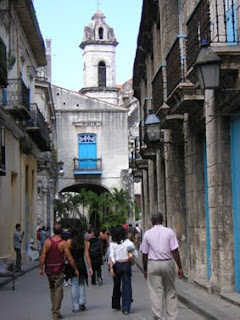C.E.U. Council for European Urbanism
CUBAN CHAPTER
The CUBAN CHAPTER OF C.E.U. acknowledges and supports the urban traditions of the country and their good practices along centuries with mostly a European influence, thus it is committed to preserve them and apply them to new developments to foster historical continuity.
The CUBAN CHAPTER OF C.E.U. believes that everything is connected with everthing else so it advocates the reconciliation of both human needs and ecological imperatives. It is against the waste of natural and cultural resources derived from sprawl and the erosion of society's built heritage. It is also against any racial, social or cultural segregation and the loss of cultural identity.
The CUBAN CHAPTER OF C.E.U. honors all principles stated in both the Charter for European Urbanism and The Charter of the New Urbanism but incorporates those suitable for our country.
The CUBAN CHAPTER OF C.E.U. perceives itself as part of a long tradition in Urbanism spanning through five centuries with mostly a European influence.
The CUBAN CHAPTER OF C.E.U. is aware that Cuban cities have not undergone the traumatic processes of urban renewal and destruction that most cities in the world have for still intact inner city cores are a distinct Cuban feature to be protected as well as their environs and countryside.
The CUBAN CHAPTER OF C.E.U. stands for the restoration of existing urban centers and towns within coherent metropolitan regions, the reconfiguration of sprawling suburbs into communities of real neighborhoods and diverse districts, the conservation of natural environments and the preservation of our built legacy.
The CUBAN CHAPTER OF C.E.U. advocates the restructuring of public policy and development practices in order to achieve diverse communities designed for the pedestrian and transit as well as the car.
lunes, 3 de mayo de 2010
domingo, 2 de mayo de 2010



Christopher Columbus arrived in Cuba on October 28th, 1492 and he was amazed by the natural beauty of the region of Baracoa, in the northern shore of Cuba for after a while he wrote in his diary 'This is the loveliest land ever beheld by human eyes'.
Conquest and colonization came next with the foundation of the first settlements1 —called villas— by Diego Velazquez along the island which had a primitive lay out based mostly on geographical features and strategic and economic criteria as no urban structure existed when the Spaniards came to the island.
An unprecedented process —since the Roman Empire— approached from the standpoint of urban planning followed: cities, towns, and buildings were shaped only with the European settler’s previous experiences and pragmatism that confronted the need for adaptation to the local climate and the availability of materials that were at hand. The progressive assimilation of the urban and architectural models from the old continent helped mold a vernacular style in time that still today informs the country’s highly distinct architectural heritage spanning over five centuries: a variation on the infinite theme of building. This reflects the country’s development and —together with the mark left by immigrants of diverse origins— defines its cultural identity.
Colonial Urbanism
Genius loci is a Roman concept. According to ancient Roman belief every 'independent' being has its genius, its guardian spirit. This spirit gives life to people and places, accompanies them from birth to death, and determines their character or essence.
Christian Norberg-Schulz: Genius Loci, Towards a Phenomenology of Architecture, p.18
The first settlements originally founded in Cuba from the beginning of the XVI century followed no guidelines at all and had a primitive lay out based either upon topography or on any other feature like the existence of a river or of an aboriginal settlement. The Spaniards soon knew that there was no gold in Cuban mines for which they focused on agriculture and introduced kettle in subsequent trips from Spain.
Etiquetas:
Colonial urbanism,
Cuba,
urban models,
urban planning
Suscribirse a:
Comentarios (Atom)
